What's inside
What's inside
 Key Ingredients
Key Ingredients

 Benefits
Benefits

 Concerns
Concerns

 Ingredients Side-by-side
Ingredients Side-by-side

Water
Skin ConditioningCyclomethicone
EmollientZinc Oxide
Cosmetic ColorantPropanediol
SolventCI 77891
Cosmetic ColorantDicaprylyl Carbonate
EmollientPolyglyceryl-3 Polydimethylsiloxyethyl Dimethicone
Skin ConditioningCaprylyl Methicone
Skin ConditioningCetyl Ethylhexanoate
Emollient1,2-Hexanediol
Skin ConditioningDisteardimonium Hectorite
StabilisingMagnesium Sulfate
Salvia Hispanica Seed Extract
EmollientCentella Asiatica Extract
CleansingHouttuynia Cordata Extract
Skin ConditioningC30-45 Alkyl Cetearyl Dimethicone Crosspolymer
EmollientHydrogen Dimethicone
Aluminum Hydroxide
EmollientPolyglyceryl-2 Dipolyhydroxystearate
Skin ConditioningStyrene/Acrylates Copolymer
Stearic Acid
CleansingFructooligosaccharides
HumectantSaccharide Hydrolysate
HumectantRosmarinus Officinalis Leaf Oil
MaskingPullulan
Pentylene Glycol
Skin ConditioningEthylhexylglycerin
Skin ConditioningOctyldodecanol
EmollientPanthenol
Skin ConditioningEchium Plantagineum Seed Oil
Skin ConditioningCardiospermum Halicacabum Flower/Leaf/Vine Extract
Skin ConditioningHelianthus Annuus Seed Oil Unsaponifiables
EmollientButylene Glycol
HumectantDibutyl Adipate
EmollientCaprylic/Capric Triglyceride
MaskingUndecane
EmollientTridecane
PerfumingTocopherol
AntioxidantPhosphatidylcholine
EmulsifyingDimethicone Crosspolymer
Emulsion StabilisingPhenyl Trimethicone
Skin ConditioningPinus Pinaster Bark Extract
AntioxidantCeramide NP
Skin ConditioningGlycine
BufferingGlutamic Acid
HumectantSerine
MaskingLysine
Skin ConditioningAlanine
MaskingArginine
MaskingThreonine
Proline
Skin ConditioningHelianthus Annuus Seed Oil
EmollientWater, Cyclomethicone, Zinc Oxide, Propanediol, CI 77891, Dicaprylyl Carbonate, Polyglyceryl-3 Polydimethylsiloxyethyl Dimethicone, Caprylyl Methicone, Cetyl Ethylhexanoate, 1,2-Hexanediol, Disteardimonium Hectorite, Magnesium Sulfate, Salvia Hispanica Seed Extract, Centella Asiatica Extract, Houttuynia Cordata Extract, C30-45 Alkyl Cetearyl Dimethicone Crosspolymer, Hydrogen Dimethicone, Aluminum Hydroxide, Polyglyceryl-2 Dipolyhydroxystearate, Styrene/Acrylates Copolymer, Stearic Acid, Fructooligosaccharides, Saccharide Hydrolysate, Rosmarinus Officinalis Leaf Oil, Pullulan, Pentylene Glycol, Ethylhexylglycerin, Octyldodecanol, Panthenol, Echium Plantagineum Seed Oil, Cardiospermum Halicacabum Flower/Leaf/Vine Extract, Helianthus Annuus Seed Oil Unsaponifiables, Butylene Glycol, Dibutyl Adipate, Caprylic/Capric Triglyceride, Undecane, Tridecane, Tocopherol, Phosphatidylcholine, Dimethicone Crosspolymer, Phenyl Trimethicone, Pinus Pinaster Bark Extract, Ceramide NP, Glycine, Glutamic Acid, Serine, Lysine, Alanine, Arginine, Threonine, Proline, Helianthus Annuus Seed Oil
Water
Skin ConditioningC12-15 Alkyl Benzoate
AntimicrobialTitanium Dioxide
Cosmetic ColorantMethyl Trimethicone
Skin ConditioningPropanediol
SolventCyclohexasiloxane
EmollientButylene Glycol
HumectantSilica
AbrasivePolymethylsilsesquioxane
Aluminum Stearate
Cosmetic ColorantPolyhydroxystearic Acid
Emulsifying1,2-Hexanediol
Skin ConditioningMorus Alba Leaf Extract
Skin ConditioningSalix Alba Bark Extract
AstringentPanax Ginseng Root Extract
EmollientMelaleuca Alternifolia Leaf Extract
PerfumingTerminalia Ferdinandiana Fruit Extract
AntioxidantFructan
Skin ConditioningSodium Hyaluronate
HumectantPhlox Drummondii Seed Extract
Skin ConditioningBiosaccharide Gum-4
Skin ConditioningMadecassoside
AntioxidantMadecassic Acid
Skin ConditioningAsiaticoside
AntioxidantAsiatic Acid
Skin ConditioningPanthenol
Skin ConditioningPentylene Glycol
Skin ConditioningCaprylic/Capric Triglyceride
MaskingAlumina
AbrasiveAmmonium Acryloyldimethyltaurate/Vp Copolymer
Polyacrylate Crosspolymer-6
Emulsion StabilisingSodium Acrylate/Sodium Acryloyldimethyl Taurate Copolymer
Emulsion StabilisingSodium Stearoyl Glutamate
CleansingPolyisobutene
Hydroxypropyl Methylcellulose Stearoxy Ether
Stearic Acid
CleansingEthylhexylglycerin
Skin ConditioningXanthan Gum
EmulsifyingSorbitan Oleate
EmulsifyingCaprylyl/Capryl Glucoside
CleansingT-Butyl Alcohol
PerfumingMethylpropanediol
SolventMaltodextrin
AbsorbentTocopherol
AntioxidantParfum
MaskingWater, C12-15 Alkyl Benzoate, Titanium Dioxide, Methyl Trimethicone, Propanediol, Cyclohexasiloxane, Butylene Glycol, Silica, Polymethylsilsesquioxane, Aluminum Stearate, Polyhydroxystearic Acid, 1,2-Hexanediol, Morus Alba Leaf Extract, Salix Alba Bark Extract, Panax Ginseng Root Extract, Melaleuca Alternifolia Leaf Extract, Terminalia Ferdinandiana Fruit Extract, Fructan, Sodium Hyaluronate, Phlox Drummondii Seed Extract, Biosaccharide Gum-4, Madecassoside, Madecassic Acid, Asiaticoside, Asiatic Acid, Panthenol, Pentylene Glycol, Caprylic/Capric Triglyceride, Alumina, Ammonium Acryloyldimethyltaurate/Vp Copolymer, Polyacrylate Crosspolymer-6, Sodium Acrylate/Sodium Acryloyldimethyl Taurate Copolymer, Sodium Stearoyl Glutamate, Polyisobutene, Hydroxypropyl Methylcellulose Stearoxy Ether, Stearic Acid, Ethylhexylglycerin, Xanthan Gum, Sorbitan Oleate, Caprylyl/Capryl Glucoside, T-Butyl Alcohol, Methylpropanediol, Maltodextrin, Tocopherol, Parfum
 Reviews
Reviews

Ingredients Explained
These ingredients are found in both products.
Ingredients higher up in an ingredient list are typically present in a larger amount.
1,2-Hexanediol is a synthetic liquid and another multi-functional powerhouse.
It is a:
- Humectant, drawing moisture into the skin
- Emollient, helping to soften skin
- Solvent, dispersing and stabilizing formulas
- Preservative booster, enhancing the antimicrobial activity of other preservatives
Butylene Glycol (or BG) is used within cosmetic products for a few different reasons:
Overall, Butylene Glycol is a safe and well-rounded ingredient that works well with other ingredients.
Though this ingredient works well with most skin types, some people with sensitive skin may experience a reaction such as allergic rashes, closed comedones, or itchiness.
Learn more about Butylene GlycolThis ingredient is an emollient, solvent, and texture enhancer. It is considered a skin-softener by helping the skin prevent moisture loss.
It helps thicken a product's formula and makes it easier to spread by dissolving clumping compounds.
Caprylic Triglyceride is made by combining glycerin with coconut oil, forming a clear liquid.
While there is an assumption Caprylic Triglyceride can clog pores due to it being derived from coconut oil, there is no research supporting this.
Learn more about Caprylic/Capric TriglycerideEthylhexylglycerin (we can't pronounce this either) is commonly used as a preservative and skin softener. It is derived from glyceryl.
You might see Ethylhexylglycerin often paired with other preservatives such as phenoxyethanol. Ethylhexylglycerin has been found to increase the effectiveness of these other preservatives.
Panthenol is a common ingredient that helps hydrate and soothe the skin. It is found naturally in our skin and hair.
There are two forms of panthenol: D and L.
D-panthenol is also known as dexpanthenol. Most cosmetics use dexpanthenol or a mixture of D and L-panthenol.
Panthenol is famous due to its ability to go deeper into the skin's layers. Using this ingredient has numerous pros (and no cons):
Like hyaluronic acid, panthenol is a humectant. Humectants are able to bind and hold large amounts of water to keep skin hydrated.
This ingredient works well for wound healing. It works by increasing tissue in the wound and helps close open wounds.
Once oxidized, panthenol converts to pantothenic acid. Panthothenic acid is found in all living cells.
This ingredient is also referred to as pro-vitamin B5.
Learn more about PanthenolPentylene glycol is typically used within a product to thicken it. It also adds a smooth, soft, and moisturizing feel to the product. It is naturally found in plants such as sugar beets.
The hydrophilic trait of Pentylene Glycol makes it a humectant. As a humectant, Pentylene Glycol helps draw moisture from the air to your skin. This can help keep your skin hydrated.
This property also makes Pentylene Glycol a great texture enhancer. It can also help thicken or stabilize a product.
Pentylene Glycol also acts as a mild preservative and helps to keep a product microbe-free.
Some people may experience mild eye and skin irritation from Pentylene Glycol. We always recommend speaking with a professional about using this ingredient in your routine.
Pentylene Glycol has a low molecular weight and is part of the 1,2-glycol family.
Learn more about Pentylene GlycolPropanediol is an all-star ingredient. It softens, hydrates, and smooths the skin.
It’s often used to:
Propanediol is not likely to cause sensitivity and considered safe to use. It is derived from corn or petroleum with a clear color and no scent.
Learn more about PropanediolStearic Acid is a fatty acid. It is an emollient, emulsifier, and texture enhancer.
As an emollient, stearic acid helps soften skin. It aids the skin's protective barrier by preventing water loss. It also provides a gentle cleansing effect without stripping away natural oils.
Stearic acid may also be used to enhance the texture of products. It can add volume and stabilize ingredients such as water and oil. This can help water and oil ingredients from separating.
Sources of stearic acid include animal or vegetable fats/oils such as coconut or shea. It can be naturally found in butter, cocoa butter, shea butter, vegetable fats, and animal tallow.
This ingredient may not be Malassezia folliculitis, or fungal-acne safe.
Learn more about Stearic AcidTocopherol (also known as Vitamin E) is a common antioxidant used to help protect the skin from free-radicals and strengthen the skin barrier. It's also fat soluble - this means our skin is great at absorbing it.
Vitamin E also helps keep your natural skin lipids healthy. Your lipid skin barrier naturally consists of lipids, ceramides, and fatty acids. Vitamin E offers extra protection for your skin’s lipid barrier, keeping your skin healthy and nourished.
Another benefit is a bit of UV protection. Vitamin E helps reduce the damage caused by UVB rays. (It should not replace your sunscreen). Combining it with Vitamin C can decrease sunburned cells and hyperpigmentation after UV exposure.
You might have noticed Vitamin E + C often paired together. This is because it is great at stabilizing Vitamin C. Using the two together helps increase the effectiveness of both ingredients.
There are often claims that Vitamin E can reduce/prevent scarring, but these claims haven't been confirmed by scientific research.
Learn more about TocopherolWater. It's the most common cosmetic ingredient of all. You'll usually see it at the top of ingredient lists, meaning that it makes up the largest part of the product.
So why is it so popular? Water most often acts as a solvent - this means that it helps dissolve other ingredients into the formulation.
You'll also recognize water as that liquid we all need to stay alive. If you see this, drink a glass of water. Stay hydrated!
Learn more about Water